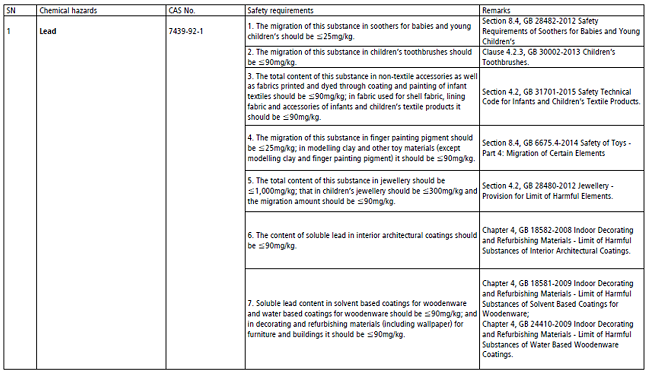China GB/T xxxxx Safety requirements for hazardous chemicals in consumer products
Little Pro on 2017-05-08
China GB/T xxxxx Safety requirements for hazardous chemicals in consumer products is a draft recommended national standard published by China's National Consumer Product Safety Standardisation Technical Commission in April 2017.
Updates: The standard GB/T 39498-2020 Guidelines for Controlling the Use of Key Chemical Substances in Consumer Products (in Chinese) has already been published in 2020 and will come into force on 1 Jun 2021.
Reference:
The draft standard is also known as the Chinese version of EU REACH annex XVII restricted substances list. If adopted, the standard will restrict 103 chemical substances in various consumer products such as toys, textiles, coatings, batteries, personal care products and furniture. Implementation date is not given yet.
Some of those restricted substances include:
- Heavy metals such as Pb, Cd, Hg ,Cr (VI), Ba, Ni, Co, As, Cu;
- PAHs;
- PFOS
- Phenols including BPA;
- Volatile organic compounds (VOC) such as benzene, xylene,
Note: xxxxx means that the code of this standard has not been assigned yet. It is misleading and wrong to call the draft standard Chinese SVHC list for 3 reasons:
- The list is only relevant to substance restriction in consumer products;
- Substances subject to authorization will not be chosen from the list;
- Articles containing more than 0.1% hazardous substances on the list do not need to be notified.
Source of Restricted Substances List
The draft standard is mainly based on the EU REACH annex XVII and other existing national safety standards related to consumer products. Some hazardous substances which are not restricted under REACH, such as MBT (CAS No. 149-30-4), and 2,2'-methylene-bis (4-methyl-6-tert-butylphenol) are also included.
Source of Limit Values
For domestic consumer products whether national standards already exist, the limit values in the national standards are used. For products and hazardous substances for which there are no existing restrictions, the draft standard refers to the EU REACH regulation, EN71-9: General Safety Requirements for Organic Compounds in Toys, EN71-12: 2013 Toy Safety - Section 12 N-Nitrosamines and N-Nitroso Compounds, Eco-Textiles Standard Oeko-tex100 -2017 and other foreign standards.
Example: Organostannic compounds
The table below is an example of restriction conditions for organostannic compounds in the draft standard.
| Index No. | Chemical Name | Restriction Conditions | Remark |
|---|---|---|---|
|
11 |
Organostannic compounds |
|
EU REACH Regulation (EC) No. 1907/2006 (link) |
Here is the screenshot of the translated standard for lead restriction in consumer products.

Download the Draft Standard
- http://www.cnis.gov.cn/wzgg/201703/t20170330_22259.shtml [Free, in Chinese]
For information on English translation, please contact us. Quality of translation is guaranteed.
Having Questions?
We do not provide consultancy services. If you have questions or need any help, please contact our sponsor. You may also find an expert in CSP business directory below. If you are a consultant, you may get yourself listed in CSP business directory (free) or sponsor this page to leave your contact info on this page..

Tags: Topics - China, Substance Restriction in Articles